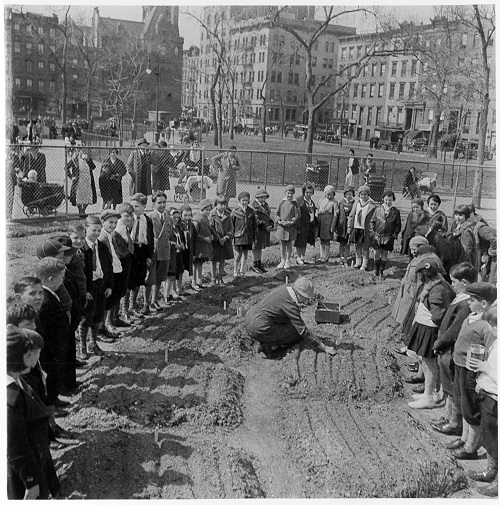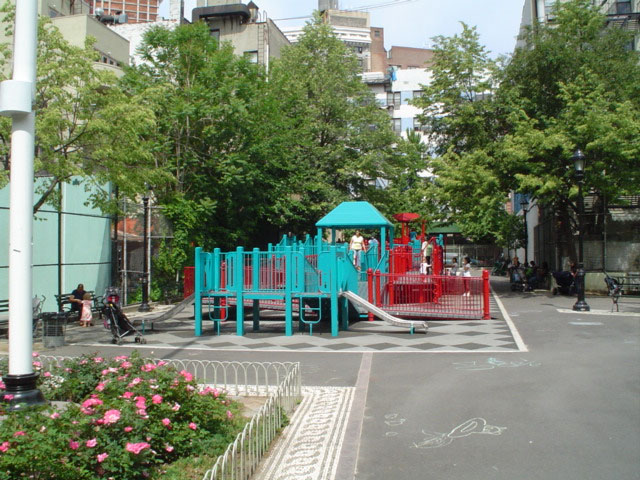Making a Place for Play — WPA Era Neighborhood Playgrounds in our Neighborhoods

Approved as part or the New Deal on April 8th, 1935, the Works Progress Administration (WPA) had a significant impact on our neighborhoods’ social resources and cultural capital. Considered to be one of 20th century America’s largest investments in social infrastructure, the Works Progress Administration (WPA) pursued over 26 different projects in the Greenwich Village, East Village, and NoHo, even employing several well-known artists like Jackson Pollock and Berenice Abbott during the beginning of their careers. As part of its intention to help Americans recover from the Great Depression, the WPA also dedicated large portions of its work to provide childcare for the working class. Many of these projects took place as federally funded nursery schools and playgrounds where parents could provide their children with physical education and day-care. Fortunately for us, our neighborhoods have 6 different sites where WPA-era playgrounds provided our communities with places for play, care, and education.



When looking at our neighborhood’s playgrounds in the context of historic preservation, it’s interesting to see them less as sites of architectural beauty and more for their impact on our communities’ younger residents as places of play and education. Before the 1900s, parks were often not built or maintained by government but provided as gifts by wealthy individuals and philanthropic organizations. These early playgrounds were heavily supervised and regimented by park attendants who taught children to learn social standards that would benefit them in their factory jobs (Child Labor reform was only widely popular after the turn of the century and finally outlawed by the Fair Labor Standards Act in 1938). Our city’s first municipal built playground was Seward Park, which opened on October 17 in 1933 on the Lower East Side. The park was the city’s experiment in free play and physical education, providing local children with a farming garden, running track, and large community center with a gymnasium. The experiment was a success, and, on opening day, the New York Times reported that nearly 20,000 children mobbed the park’s facilities. By 1908, two of these state-of the art playgrounds were established in our own neighborhoods at both the East River and Tompkins Square Parks.

The WPA carried on in this legacy to establish permanent places to support children’s needs, and, somewhat ironically, most of these projects were supervised by the Park Commissioner Robert Moses (who infamously sought to divide our neighborhoods with road and highway extensions throughout his tenure as a city official between 1934 and 1975). Before this, Moses and the NYC Parks department sought to use WPA federal relief funding to provide places for clean, open play that would entice children away from playing on the street, avoiding juvenile delinquency and accidental injury. Many of the playground openings were grand events featuring speeches by local politicians and dignitaries as well as musical and theatrical performances. With WPA funding from the 1930s-’50s, the number of city playgrounds expanded from 119 to 770. These parks established the typical archetype that we recognize today: playgrounds composed of large asphalt areas with seesaws, sandboxes, and metal jungle gyms with monkey bars, swing sets, and slides. Recreation Specialists also staffed these parks, but, unlike their predecessors, worked to assist families with childcare and activities that inspired their natural curiosity rather than stifle it with heavy supervision and behavioral restrictions. Many of these WPA-era playgrounds still exist in our neighborhoods, albeit with some modern renovations. Explore the parks below with descriptions provided from the Living New Deal blog, an excellent resource to further explore the New Deal’s contributions to our communities. You can also learn more about the histories of important places in the our neighborhoods by visiting our Greenwich Village Historic District Map and our East Village Building Blocks websites
East Village
Joseph E. Sauer Park
(Located at East 12th Street between Avenues A and B)
Sauer Park is one of nine playgrounds that were built by the Parks Department through the War Memorial Fund, and were opened simultaneously on July 15, 1934. The site had previously been an abandoned school building (P.S. 126), which the city turned over to the Parks Commissioner for demolition by a Civil Works Administration (CWA) crew. Parks first acquired the land for Sauer Park in 1934 and expanded the site with subsequent additions in 1965, 1989, and 1992.

Tompkins Square Park Playground
(Located between East 9th and 10th Streets and between Avenues A and B)
This sizeable Manhattan park has served as a recreational space since the early 19th century. In the 1930s, it was redesigned under Parks commissioner Robert Moses. On October 1, 1936, Parks announced that the: “north half of the park from Ninth to Tenth Streets between Avenues A and B has been redesigned and reconstructed and includes basketball, volleyball, shuffleboard, paddle tennis and horse-shoe pitching courts; complete play apparatus and wading pool.

First Park
(Located on the corner of East 1st Street and 1st Avenue)
This park is named for its location near East First Street and First Avenue. First Park opened in 1935, and was a typical product of the WPA (Works Progress Administration) initiative to create recreational areas in the city. Following a period of neglect, this park was reclaimed by a series of neighborhood organizations working with City officials to once again provide a welcome respite from the surrounding traffic.

Greenwich Village
Minetta Playground
(Located on the corner of West 3rd Street & 6th Avenue):
The NYC Parks site explains the origins of this playground: In 1934 Board of Transportation granted the Department of Parks a permit to develop this parcel as a playground which opened the following year. The November 1935 press release announcing the playground’s official opening explained that it and the other six playgrounds opened on the same day (one of which was attended by WPA administrator Harry Hopkins), collectively contained: “2 basketball diamonds, 1 basketball court, 4 bocci courts, 4 handball courts, 2 horizontal bars, 2 horizontal ladders and 3 horseshoe pitching courts for adults; for the youngsters, 6 jungle gyms, 96 kindergarten swings, 9 large slides, 72 large swings, 1 paddle tennis court, 4 parallel bars, 14 playhouses, 6 sand tables, 36 see-saws, 6 shuffleboard courts, 4 small slides and 3 wading pools.

South Village
Playground of the Americas
(Located on the corner of West Houston Street and 6th Avenue)
The NYC Parks Department describes the origins of the park: “In 1925, the City of New York acquired this property and transferred it to the Department of Transportation as part of a Sixth Avenue renovation. The Board of Estimate placed the parcel under Parks jurisdiction in May 1934, and the playground was constructed in 1935. It remained unnamed until February 1998, when Parks designated it Houston Plaza. In 2000, it was renamed Playground of the Americas.

Vesuvio Playground
(Located at 99 Thompson Street)
Originally known simply as the playground at 99 Thompson St., this was one of fourteen new playgrounds throughout New York to open in August, 1934. The labor and materials for all these playgrounds were provided by “Work Relief funds.” Given the timing, Relief funds mentioned most likely came at least partly from the CWA. The Parks Department press release announcing the opening described this playground as containing “Recreation building, a wading pool in the center of the play area, and [the] usual apparatus for small children including sand tables, see-saws and slides. This is distinctly a playground for small children.” At the time, the park was only 75 ft. x 95 ft.. In 1957, the Parks Department acquired adjacent space to the South and West and expanded the playground to its current size with significant redevelopment of the entire space. The playground is now named “Vesuvio” after the well known Italian bakery around the corner.

Further Reading:
- “The Surprising History of Politics and Design in Playgrounds” by Ariel Aberg-Riger for Bloomberg CityLab.
- “The History of Playgrounds in Parks” from the NYC Parks Department.
- “How We Came to Play: The History of Playgrounds” by Kaitlin O’Shea for SavingPlaces.org & the National Trust for Historic Preservation.
